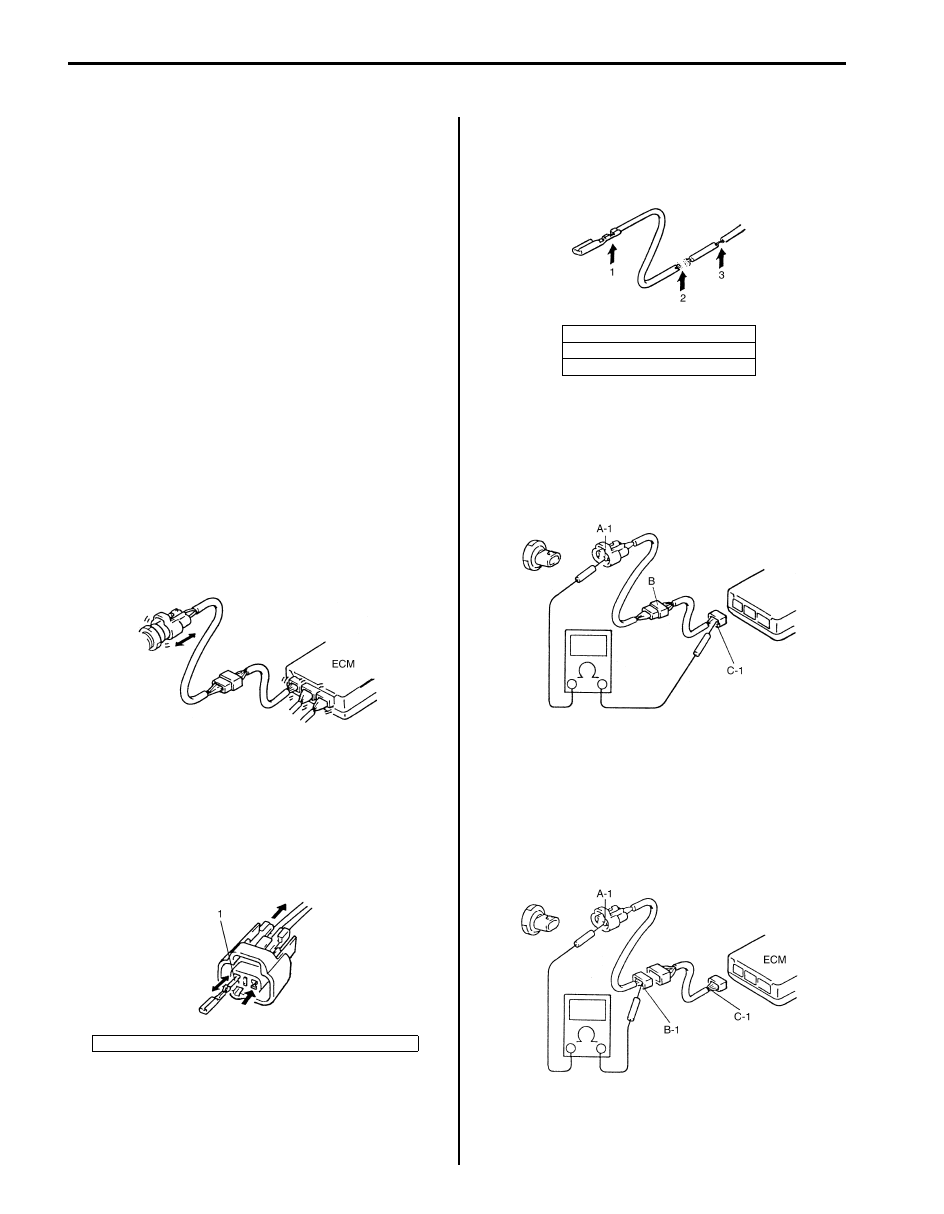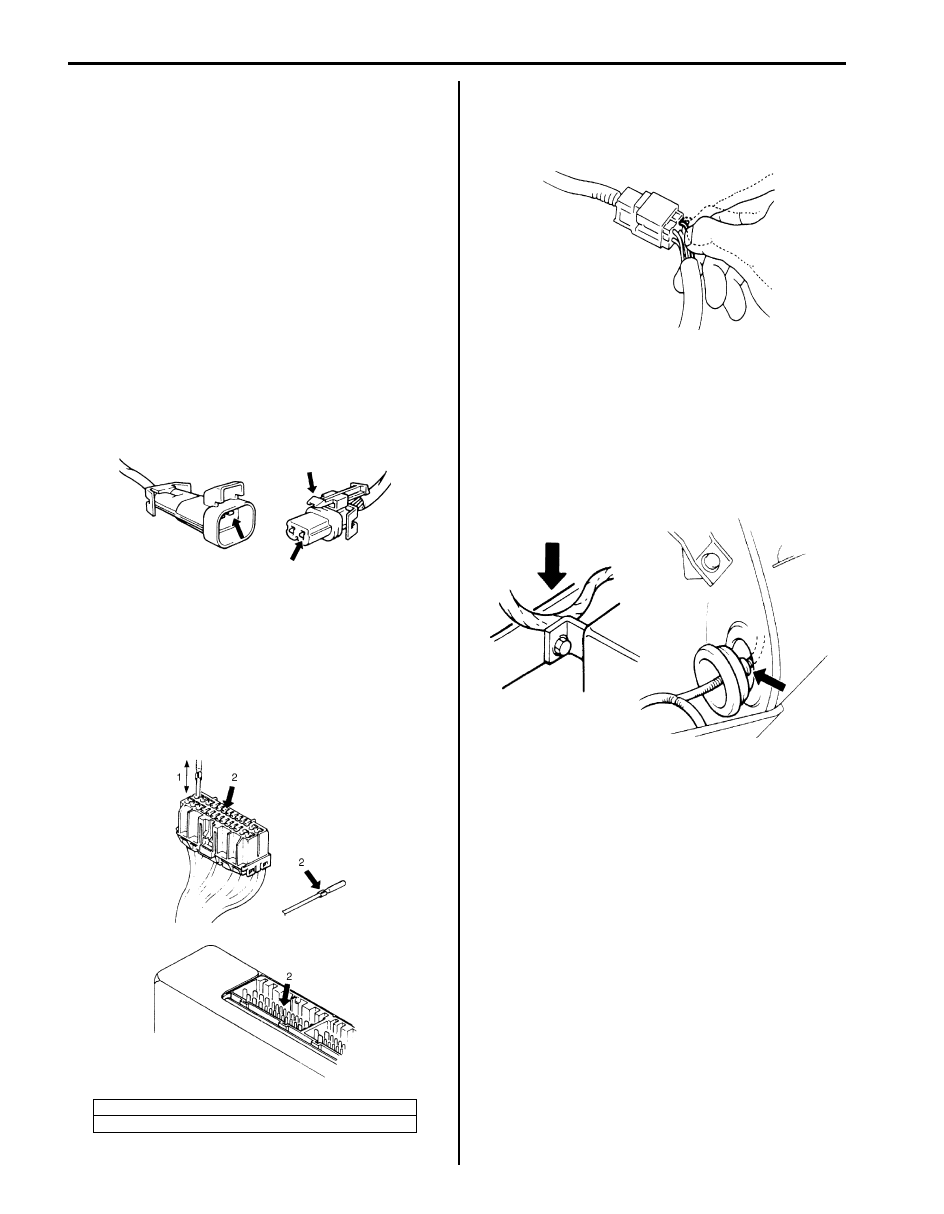Suzuki Grand Vitara JB416 / JB420. Manual — part 4

00-13 Precautions:
Repair Instructions
Electrical Circuit Inspection Procedure
S5JB0A0006001
While there are various electrical circuit inspection
methods, described here is a general method to check
its open and short circuit by using an ohmmeter and a
voltmeter.
Open Circuit Check
Possible causes for the open circuit are as follows. As
the cause is in the connector or terminal in many cases,
they need to be checked particularly carefully.
• Loose connection of connector
• Poor contact of terminal (due to dirt, corrosion or rust
on it, poor contact tension, entry of foreign object etc.)
• Wire harness being open
When checking system circuits including an electronic
control unit such as ECM, TCM, ABS control module,
etc., it is important to perform careful check, starting with
items which are easier to check.
1) Disconnect negative cable from battery
2) Check each connector at both ends of the circuit
being checked for loose connection. Also check lock
condition of connector if equipped with connector
lock.
3) Using a test male terminal, check both terminals of
the circuit being checked for contact tension of its
female terminal. Check each terminal visually for
poor contact (possibly caused by dirt, corrosion, rust
entry of foreign object, etc.). At the same time, check
to make sure that each terminal is locked in the
connector fully.
4) Using continuity check or voltage check the following
procedure, check the wire harness for open circuit
and poor connection with its terminals. Locate
abnormality, if any.
Continuity Check
1) Measure resistance between connector terminals at
both ends of the circuit being checked (between “A-
1” and “C-1” in the figure). If no continuity is indicated
(infinity or over limit), that means that the circuit is
open between terminals “A-1” and “C-1”.
2) Disconnect the connector included in the circuit
(connector-B in the figure) and measure resistance
between terminals “A-1” and “B-1”.
If no continuity is indicated, that means that the
circuit is open between terminals “A-1” and “B-1”. If
continuity is indicated, there is an open circuit
between terminals “B-1” and “C-1” or an abnormality
in connector-B.
1. Check contact tension by inserting and removing just for once.
I2RH01010049-01
I2RH01010050-01
1. Looseness of crimping
2. Open
3. Thin wire (single strand of wire)
I2RH01010051-01
I2RH01010052-01
I2RH01010053-01

Precautions: 00-14
Voltage Check
If voltage is supplied to the circuit being checked, voltage
check can be used as circuit check.
1) With all connectors connected and voltage applied to
the circuit being checked, measure voltage between
each terminal and body ground.
a) If measurements were taken as shown in the
figure and results were as listed in the following,
it means that the circuit is open between
terminals “B-1” and “A-1”.
Voltage between each terminal and body
ground
“C-1” and body ground: Approx. 5 V
“B-1” and body ground: Approx. 5 V
“A-1” and body ground: 0 V
b) Also, if measured values were as listed in the
following, it means that there is a resistance
(abnormality) of such level that corresponds to
the voltage drop in the circuit between terminals
“A-1” and “B-1”.
Voltage between
“C-1” and body ground: Approx. 5 V
“B-1” and body ground: Approx. 5 V
“A-1” and body ground: Approx. 3 V
“A-1” and “B-1”: 2V voltage drop
Short Circuit Check (Wire Harness to Ground)
1) Disconnect negative cable at battery.
2) Disconnect connectors at both ends of the circuit to
be checked.
NOTE
If the circuit to be checked is connected to
other parts (1), disconnect all connectors of
those parts.
Otherwise, diagnosis will be misled.
3) Measure resistance between terminal at one end of
circuit (“A-1” terminal in the figure) and body ground.
If continuity is indicated, it means that there is a short
to ground between terminals “A-1” and “C-1” of the
circuit.
4) Disconnect the connector included in circuit
(connector B) and measure resistance between “A-
1” and body ground.
If continuity is indicated, it means that the circuit is
shorted to the ground between terminals “A-1” and
“B-1”.
I5RH01000005-01
1. To other parts
1. To other parts
I5RH01000006-01
I2RH01010056-01

00-15 Precautions:
Intermittent and Poor Connection Inspection
S5JB0A0006002
Most intermittent are caused by faulty electrical
connections or wiring, although a sticking relay or
solenoid can occasionally be at fault. When checking it
for proper connection, perform careful check of suspect
circuits for:
• Poor mating of connector halves, or terminals not fully
seated in the connector body (backed out).
• Dirt or corrosion on the terminals. The terminals must
be clean and free of any foreign material which could
impede proper terminal contact. However, cleaning
the terminal with a sand paper or the like is prohibited.
• Damaged connector body, exposing the terminals to
moisture and dirt, as well as not maintaining proper
terminal orientation with the component or mating
connector.
• Improperly formed or damaged terminals.
Check each connector terminal in problem circuits
carefully to ensure good contact tension by using the
corresponding mating terminal.
If contact tension is not enough, reform it to increase
contact tension or replace.
• Poor terminal-to-wire connection.
Check each wire harness in problem circuits for poor
connection by shaking it by hand lightly. If any
abnormal condition is found, repair or replace.
• Wire insulation which is rubbed through, causing an
intermittent short as the bare area touches other
wiring or parts of the vehicle.
• Wiring broken inside the insulation. This condition
could cause continuity check to show a good circuit,
but if only 1 or 2 strands of a multi-strand-type wire
are intact, resistance could be far too high.
If any abnormality is found, repair or replace.
1. Check contact tension by inserting and removing just once.
2. Check each terminal for bend and proper alignment.
I2RH01010057-01
I5RH01000007-01
I2RH01010059-01
I2RH01010060-01
Table of Contents 0- i
0
Section 0
CONTENTS
General Information
General Information . . . . . . . . 0A-1
General Description . . . . . . . . . . . .0A-1
Abbreviations . . . . . . . . . . . . . .. 0A-1
Symbols . . . . . . . . . . . . . . . .. 0A-2
Wire Color Symbols . . . . . . . . . . . 0A-3
Fastener Information. . . . . . . . . . ... 0A-3
Vehicle Lifting Points. . . . . . . . . . ... 0A-5
Engine Supporting Points . . . . . . . . ... 0A-7
Vehicle Identification Number . . . . . . . . 0A-7
Engine Identification Number. . . . . . . .. 0A-7
Transmission Identification Number. . . . . 0A-7
Component Location . . . . . . . . . . ...0A-8
Warning, Caution and Information Label
Location . . . . . . . . . . . . . . . 0A-8
Maintenance and Lubrication. . . . . 0B-1
Precautions. . . . . . . . . . . . . . ...0B-1
Precautions for Maintenance and Lubrication. . 0B-1
Scheduled Maintenance . . . . . . . . . ..0B-1
Maintenance Schedule under Normal Driving
Conditions . . . . . . . . . . . . . . . 0B-1
Maintenance Recommended under Severe
Driving Conditions. . . . . . . . . . . . 0B-2
Repair Instructions . . . . . . . . . . . ..0B-4
Engine Accessory Drive Belt Inspection . . . . 0B-4
Engine Accessory Drive Belt Replacement. . . 0B-4
Valve Lash (Clearance) Inspection . . . . . . 0B-4
Engine Oil and Filter Change. . . . . . . .. 0B-5
Engine Coolant Change. . . . . . . . . .. 0B-6
Exhaust system Inspection . . . . . . . . . 0B-7
Spark Plugs Replacement . . . . . . . . .. 0B-7
Air Cleaner Filter Inspection. . . . . . . . 0B-7
Air Cleaner Filter Replacement . . . . . . ... 0B-7
Fuel Lines and Connections Inspection . . . .. 0B-7
Fuel Filter Replacement. . . . . . . . . .. 0B-7
Fuel Tank Inspection. . . . . . . . . . ... 0B-7
Crankcase Ventilation Hoses and
Connections Inspection (Vehicle without A/F
Sensor). . . . . . . . . . . . . . . ..0B-7
PCV Valve Inspection . . . . . . . . . . .0B-7
Fuel Evaporative Emission Control System
Inspection. . . . . . . . . . . . . . ..0B-8
Brake Discs and Pads Inspection . . . . . ...0B-8
Brake Drums and Shoes Inspection. . . . . 0B-8
Brake Hoses and Pipes Inspection . . . . . .0B-8
Brake Fluid Change . . . . . . . . . . . 0B-9
Parking Brake Lever and Cable Inspection. . .0B-9
Clutch Fluid Inspection. . . . . . . . . . 0B-9
Tire / Wheel Inspection and Rotation . . . . ..0B-9
Wheel Discs Inspection. . . . . . . . . .0B-10
Wheel Bearing Inspection . . . . . . . . .0B-10
Suspension System Inspection . . . . . . .0B-10
Steering System Inspection . . . . . . . ..0B-10
Propeller Shafts and Drive Shafts Inspection. 0B-11
Manual Transmission Oil Inspection . . . . .0B-11
Manual Transmission Oil Change . . . . . .0B-12
Automatic Transmission Fluid Inspection. . ..0B-12
Automatic Transmission Fluid Change . . . .0B-12
Automatic Transmission Fluid Cooler Hose
Inspection. . . . . . . . . . . . . . 0B-12
Change. . . . . . . . . . . . . . . 0B-12
Specifications. . . . . . . . . . . . . .0B-15
Tightening Torque Specifications. . . . . ..0B-15
Special Tools and Equipment . . . . . . ...0B-15
Recommended Fluids and Lubricants. . . ...0B-15
Special Tool . . . . . . . . . . . . . ..0B-15

Нет комментариевНе стесняйтесь поделиться с нами вашим ценным мнением.
Текст